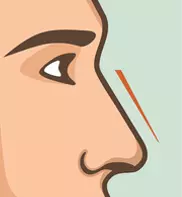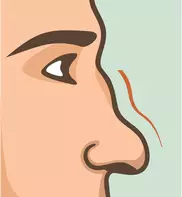How Should a Natural Nose Be?
Every person has a different nose structure. Some people are not satisfied with the very diverse nose structure. The nose is the first organ of the upper respiratory system. Apart from its first function which allows us to breathe properly the nose is located in the middle of our facial structure. Nose surgery is required for the treatment of problems in the nose that cause breathing problems and affect the general quality of life of the person. One of the issues that people who want to have nose surgery most afraid of is whether their nose will have a natural appearance after nose surgery. If you are reading this article, you must be asking yourself this question “I Want a Natural Nose. Is It Apparent That I Have Aesthetics?” TAŞ Aesthetic Surgery Center prepared a blog post for those who want to have rhinoplasty and ask the question “How is a natural rhinoplasty done?”. In our blog post today we will share with you the answers to your questions such as How should the ideal nose structure be? How to achieve a natural nose structure with rhinoplasty?.
What is the Ideal Nose?
The ideal nose is a concept that is suitable for each individual’s face type and varies from individual to individual, and cannot be generalized. In order to achieve the ideal nose, criteria such as symmetry, proportion, harmony, naturalness and function must be met. Thus, the ideal, that is, natural nose surgery conditions for the person are achieved.
What Should Be the Natural Nose Size and Shape?
It should be taken care of to ensure that the nose structure is proportional to the other features of the face. The secret of a good nose is the structure of the nose, which is not known to have been operated on aesthetically, but is compatible with the facial features and dimensions. For this, the nose structure that makes up the nose, such as the tip of the nose, the bridge of the nose, the wings of the nose and the nostrils, must be proportional and in harmony with each other. In the ideal nose size, points such as the person’s unique face shape and angle of the tip are decisive. The golden ratio is very important in rhinoplasty, which is the most striking part of the face. At this point, rhinoplasty operations should be planned according to the golden ratio. As in all aesthetic operations, the most important point in rhinoplasty is to produce an ideal and natural-looking result for the patient.
Customized Nose Features
-
Gender
Women have a more sensitive nose structure than men. It is generally smaller, narrower and less projective. The nasal dorsal is more concave, while in the male it is flat and a little convex.
| Click to get detailed information about Rhinoplasty for Male. |
-
Ethnicity
Ethnic term; refers to a group of people who share a common racial, cultural, national, religious or linguistic heritage. Ethnic Rhinoplasty, on the other hand, is a natural rhinoplasty with features depending on the race (European, African, Middle Eastern, Latin American, Asian and Hispanic) people belong to. There is a different nose structure for each ethnicity and nose surgery is performed according to this nose structure.
| Click to get detailed information about Ethnic Rhinoplasty. |
-
Big and Long Nose
We can say that the big and long nose type is the most common nose type in people. The fact that the nose is larger than the facial features of the person affects the person and forces him to have rhinoplasty. The important thing here is again the choice of the surgeon. In individuals with a large and long nose, the nasal skeleton becomes smaller while the nose surgery is performed, but the amount of skin remains the same. The skin adapts to the underlying skeleton and is attempted to be reduced in size as much as the tissues allow that to do, depending on the quality of the skin. For thick skinned patients they need to prepare their skin before surgery with fractional resurfacing CO2 laser treatment to help the skin to shrink during the surgery. It takes 1-2 years for the nose shape to fully settle. Rhinoplasty results in a 20-25% reduction. More than that is simply not possible. The reason for this is that we cannot reduce the skin structure on the nose while reducing the bone and cartilage structure of the nose. This is due to the fact that the skin is too large for the structure of the newly formed nose.
| Click to get detailed information about Big and Long Nose Rhinoplasty |
-
Humpy Nose
During the development period, a hump may occur in your nose structure. With the development and completion of the bone structure during adolescence, the humpy nose structure in the genes begins to become evident. In addition to the gene structure, a humpy nose structure may occur as a result of blows, bumps, and falls during childhood.
| Click to get detailed information about Humpy Nose. |
What Should the Natural Nose Size Be According to Nose Angles?
Nasofrontal Angle: The nasofrontal angle shows how the nasal bone articulates with the glabella and brow. Ideally, the nose should have a small indentation at the point where the nose meets the glabella (the area between the two brow ridges of the forehead) and the eyebrow.
Nasal Angle: The nasal angle gives us information about how the nose tip structure fits with the rest of the nose. It is absolutely essential to evaluate this angle in patients who want to change the appearance of the nasal tips. Poorly protruding nose tips produce an undesirable facial aesthetic.
Nose-Jaw Angle: After evaluating the nasal angle, the chin itself is evaluated for the ideal nose. The chin is evaluated directly as the mentoservical angle. This angle directly evaluates the chin protrusion as it relates to the lip protrusion and nasal protrusion. For ideal facial aesthetics, this angle should be between 80-95 degrees.
What Should the Natural Nose Size Be According to the Face Ratio?
Face shape differs from person to person. The nose structure varies greatly according to the features of the person. The important thing in the facial area, which consists of the upper, middle and lower face parts, is to find the underlying facial skeleton. To assess facial or nasal symmetries or asymmetries, the face should be divided into five equal parts and evaluated. Your face should be divided into three vertically by taking the hairline, the tip of the nose, the upper part of the nose and the chin area. Here, in general, the horizontal axis of the nose should be equal to the horizontal axis of the eye. The upper third is the most variable, and the lower third of the face is then divided into thirds by visualizing a horizontal line between the oral commissure (stomion). The upper third of this lower part is located between the nasal base and the oral commissure, and the lower two thirds are between the commissure (stomion) and the menton. The nose length should be equivalent to the stomionto-menton distance (SM). The lower lip should be within 2 mm of this line. The ideal chin position varies by gender, with the chin slightly behind the lower lip in women and equal to the lower lip in men. In order to reveal the ideal nose structure, the person’s features and nose structure are examined and the new nose shape must be compatible with all these features in order to catch the golden ratio. Conditions for attaining the golden ratio:
- When adapting the golden ratio to rhinoplasty, it should be taken care to ensure that the nose length is equal to 1/3 of the face height,
- The ratio between the width of the nose and the width of the mouth should be compatible.
- The ratio between the length of the nose and its projection and the ratio of the sides of the face rectangle to each other should be considered.
- The ratio of the space between the eyebrows to the space between the pupils
- The ratio of the widths to the lengths of the front two teeth in the upper jaw,
- The ratio of the width of the lower lip to the width of the upper lip
Before deciding on nose surgery, shape deformities in the nose are also decisive points to achieve the natural nose structure.
How to Correct Nose Shape Deformities?
-
Septum Deviation
Septum deviation is the curvature of the bone in the nose. Septorhinoplasty surgery is performed to get rid of the bone curvature of the nose due to various reasons.
| Click to get detailed information about Septum Deviation |
-
Droopy Tip
In the ideal nose structure, there should be a 90 degree angle for males and 110 degree angle for females between the tip of the nose and the upper lip. When the tip of the nose falls, this angle becomes smaller and appears to be stuck to the lip. Especially when viewed from the side, this droopiness at the tip of the nose is easily evident. If you have a droopy nasal tip problem, you should have a nose tip surgery.
| Click to get detailed information about Droopy Tip. |
-
Nose Deformity Causes and Deformations
Bunların yanında burun şekil bozukluğu semptomları arasında nefes almada yaşanan problemler ve horlama, burunda zamanla meydana gelen kemer ve burun deliklerinde orantısızlık yer almaktadır. In addition to these, nasal deformity symptoms include breathing problems and snoring, and disproportion in the nostrils and hump that occur over time in the nose.
| Click to get detailed information about Nose Deformity Causes and Deformations |
Things to Consider in Nose Surgery for Reaching a Natural Nose
I Want a Natural Nose. Is It Apparent That I Have Had Aesthetic surgery? The answer to these questions is completely hidden in the aesthetic operation. We have stated that the concept of natural rhinoplasty will vary from person to person due to both the person’s tastes and the physical features of the face. However, natural nose surgery is possible for every person. For natural rhinoplasty, you should first choose a plastic surgeon who has proven his success in his field and whom you can trust. After you make the right choice, the things to be done in the way of natural rhinoplasty are shaped by your plastic surgeon according to your wishes. There are four parts of the nose that your plastic surgeon should consider for natural nose surgery. These sections are;
Upper part of the nose: The upper part of the nose consists of the nasal bones. If there is a deformation in the upper part of your nose and your surgeon wants to make changes at this point, equalizing the nasal bone height and the angle between the upper part of the nose and the forehead will reveal a nose structure that most patients desire. Shrinking the bone too much can cause indentation and will make it look both unnatural and the lower nose too big. This can also limit airflow, so the goal should be straightening and narrowing without overdoing it.
The middle part of the nose: There is a septum consisting of a rectangular cartilage in the middle part of the nose that separates the left and right nostrils of the nasal bones and extends quite deep into the nasal cavity. On either side of the septum is a small curve of cartilage called the upper lateral cartilage that helps keep the nasal airway open. In this area, most patients want the nose to appear straight when viewed from the front, not too wide or narrow. When viewed from the side, it is desired that this middle part of the nose be at equal height to the nasal bones. During surgery to reduce a lump or curvature in this area, the surgeon should avoid removing too much cartilage in this area. Overdoing it can interfere with breathing. Your surgeon will delicately treat this area to make it as flat as possible. Sometimes the mid nose needs to be supported with special cartilage grafts called spreader grafts that keep the airway open and help straighten the nose.
Nasal tip: The shape of the nose tip and rim consists of two curved C-shaped cartilages. Much of the aesthetics and beauty of the nose depends on the size, shape and projection of the tip. You and your surgeon can make choices about tip changes. The aim is to project the tip at the same level and from the side view equal to, and perhaps slightly beyond, the height of the profile line. If the tip is drooping or less protruding outward, it may appear curved. If too much is removed from the tip, it can sometimes point too high. This is where the experience of your rhinoplasty surgeon is important. Some of the common changes are:
- Increased projection with sutures or cartilage grafts
- Reducing an over-projected tip
- Narrowing a wide or boxy tip
- To make an irregular tip more symmetrical and even
Nose Skin: Nose skin differs from person to person. In rhinoplasty surgery, the fact that the skin of the nose is thin or thick, as well as being dry and oily, affects the nose surgery. At this point, the structure of the nose skin is also very important for the emergence of the ideal nose structure. If we go into more details about what should be considered for natural nose surgery:
- The nose is an organ located in the middle of the face. When the face is considered as 3 equal parts, provided that it includes the inner canthus and lip line, the nose that is compatible and proportional with the resulting parts will be the ideal nose.
- The fact that the nostrils are parallel to the midline of the eyes helps to achieve the ideal nose proportion.
- It is very important to achieve the golden ratio in rhinoplasty for natural rhinoplasty. As a matter of fact, the sculptors of the Renaissance period used the golden ratio formula while creating their sculptures. At the point we have reached today, the golden ratio has gained importance in rhinoplasty.
- When the nose is evaluated alone, it should have harmonious proportions within itself. In addition, it should be shaped in a way that is compatible with everyone’s unique facial features.
- When we look at a person’s face, the nose comes to the forefront. Therefore, one of the conditions that must be met for a natural rhinoplasty is to adjust the front view of the nose correctly and proportionally.
- In natural nose surgery, when the post-operative swelling is gone and the shape of the nose is settled, the person will never find his own nose strange. People with thick-skinned noses may take a little longer to recover than thin-skinned noses.
Closed and Atraumatic Technique for Natural Nose Surgery
Assoc.Prof.Dr. Suleyman TAS uses Closed and Atraumatic Technique, which has a faster recovery process compared to open technique nose surgery. The main advantages of the Closed and Atraumatic technique are as follows:
- In nose surgeries performed with Closed and Atraumatic Techniques, there is no scar because the tip of the nose is not cut.
- Since the pitanguy ligament located behind the nasal tip skin is not cut, there is no dropping in the tip of the nose.
- After the nose surgery performed with the Closed and Atraumatic Technique, the mobility and softness of the nasal tip is preserved.
- When nose surgery is performed with this technique, since the number of cut nerves is less, the numbness in the nose after the surgery is less.
- Thanks to Closed Technique nose surgeries, the tip of the nose is better supported.
- Swelling that may occur after nose surgery is minimized by this technique.
| Click to get detailed information about Closed Atraumatic Technique. |
Natural Rhinoplasty Before and After Difference
Perhaps the biggest indicator of natural rhinoplasty is the comments of people you meet after rhinoplasty. Imagine meeting a new person after rhinoplasty and complimenting your nose. If this person does not ask if your nose has been operated on, you may think that the necessary procedures for natural rhinoplasty have been done. However, it is worth remembering that it takes a certain time for the structure of your nose to settle, since the swelling of the nose passes after an average of two months after the splint is removed. If you want to achieve the ideal nose structure for your face, it should not be forgotten that you should choose the right surgeon, which is important here. We have come to the end of our blog post, where we tell you how to get a natural nose structure with rhinoplasty and answered the question How should the ideal nose be? We would like to remind you that you can review our rhinoplasty page for more detailed information, and contact us for your questions on +90 543 456 36 93. Have a healthy day.




